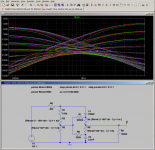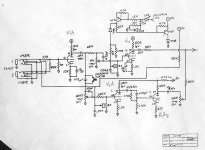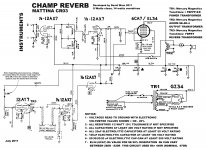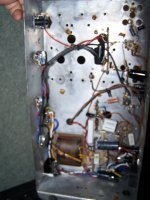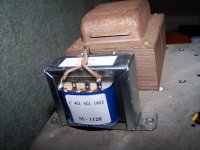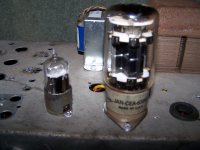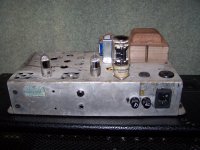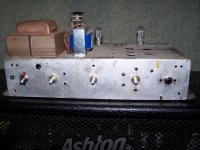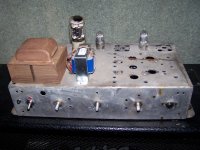That's a scary thought. My little DIY amp is not properly touch-proof yet. I better do something about that....I don't have to worry about touching the electricity with one hand while holding the guitar in the other...
That's definitely direction #6, but I forgive you, because it is a pretty interesting idea.I hate to bring up direction #6, but the single preamp - split - dual power amp with separate speakers sounds like a possibility.
It's also probably the most straightforward way to do a guitar amp with multiple-personality/dissociative identity disorder. (This one will be easy to name - the Sybil!)
My biggest worry about this approach is summed up in another comment you made:
I know I can do some things to reduce the weight - pine cab, smaller speaker drivers, smaller output transformers, maybe an SMPS power supply. But I'm still concerned that this approach will be either too heavy, or too bulky, or both.<snip>...it was too big and heavy to move.....
I have a couple of spare IKEA "Rast" pine nightstands still waiting to be turned into speaker boxes. I think one of them would be about the right size for two of those 6" drivers, and minimal woodworking would be involved. Very tempting!If you used 6 inch speakers the box wouldn't be any bigger than the dual Dayton cabinets that I have now.
I know Fender makes an "Acoustasonic" model intended for acoustic guitar. It's ear-piercingly, obnoxiously, headache-inducingly bright. A detestable product, presumably designed by a deaf engineer, and marketed to deaf musicians.The speaker in most acoustic amps is not flat.
Roland makes a few acoustic guitar amps that are intended to work as keyboard amps, small P.A. systems, or for acoustic guitar. I think these are a lot closer to a flat response, given the limitations of the relatively large driver.
There are a number of competing brands that seem to roughly follow the same template as Roland. In many cases the "full-range" driver is paired with a nasty-sounding compression tweeter.
I ended up with an Acoustic AG30 (I had two, left one behind when I moved to Canada). It too is designed to work as a small P.A. system or acoustic guitar amp. A pair works very well with electronic piano/keyboards.
The AG30 has an 8" fullrange driver, which includes a coaxially mounted Mylar dome tweeter. The bass-reflex enclosure is slot-loaded, and the front panel is angled back at about 45 degrees. To my ears, the sound is surprisingly good for this type of product - close to flat and neutral through most of the frequency range, with a little bit of "chestiness" down low, suggesting deep bass is not very well controlled.
One thing I really like about the AG30 is that there is very little of the usual boxy sound, perhaps because of the non-parallel cabinet walls. There is also none of the shrieky, peaky treble that usually goes with compression tweeters. Female vocals come through unscathed.
This sort of neutral, wide, flat response is what I prefer in an acoustic guitar amplifier. I usually run my (acoustic-electric) guitar through a graphic EQ pedal before going into the amp anyway - any tweaks I want are made there, not baked into the amp itself.
I guess I'm just wondering if a tiny amount of tubey nonlinear distortion might make an acoustic guitar sound a little warmer and prettier.
Life took me where I wasn't really intending to go. When I got back into music in 2009, I was mostly interested in playing electric guitar. But the people I got along with best were almost all into folk, country, singer-songwriter stuff, all played on acoustic guitar....but I don't play an amplified acoustic guitar.
So I reluctantly bought the cheapest acoustic guitar I could find (a $110 Kona electro-acoustic from Walmart) to tide me over until I could go all-electric. Well, seven years later, that still hasn't happened, and I now have two decent acoustic guitars. (I gave the Kona to a cash-strapped college kid who couldn't afford a guitar.)
Thank you! I've saved that image to my folder of interesting future project possibilities.Here is the output from the simulation that I used to make the box for the Dayton speakers.
-Gnobuddy
As mentioned before, of the ones I've tried so far, my favourite guitar tone control is a heavily tweaked version of the Voight tone control circuit in Merlin Blencowe's book.
I have been tinkering with the circuit in LTSpice for some time, trying both to improve it, and to visualize the effects of the two separate controls (bass and treble pots).
I think I succeeded pretty well at the first of those goals, but not the second. In a nutshell, I had LTSpice stepping both (virtual) pots through equal angles at the same time, then taking a frequency response measurement. That meant you could not see the effect of one control alone, or the results of turning the two pots in opposite directions at the same time (bass boost and treble cut at the same time, for example.)
After some tinkering today, I found a way to help visualize what each control (bass and treble) does, both individually, and together. LTSpice is now stepping each pot through ten positions individually. Since there are two pots and ten positions each, that means there are one hundred different combinations, so there are one hundred lines on the resulting frequency response graph!
Luckily for us, the shapes and spacings of the lines tell us something about the way the control operates. Take a look at the attached screenshot.
We can see, for instance, that the curves cluster together at the lower edge of the graph. In other words, both tone control knobs become ineffective near their full-cut positions.
But the big picture is a good one - lots of cut and boost are available, there is a pretty flat frequency response available with both pots centered, and interaction between the pots is pretty weak - the bass curves are not yanked all over the map when the treble pot is turned, for example. (We see rather tightly grouped clusters of curves.)
As before, R6 represents the 40k source impedance of the valve feeding the tone control; this is typical for a 100k/half-a-12AX7 common-cathode gain stage. R9 is the 1M grid bias resistance of the next stage, loading the output of the tone control. A 1M pot could be used here, too, as a master volume.
This circuit is the best I can do (so far) with a purely passive approach. IMO it's better than the TMB, passive James, passive Baxandall, and the two-knob Bandmaster tone control.
I should add that this version is tweaked for an overdriven guitar sound. Center frequency is up around 700 Hz, in the expectation that there will be lots of treble harmonics present (due to overdrive). For a clean channel, it would probably be better to drop the center frequency to the 400 Hz range.
-Gnobuddy
I have been tinkering with the circuit in LTSpice for some time, trying both to improve it, and to visualize the effects of the two separate controls (bass and treble pots).
I think I succeeded pretty well at the first of those goals, but not the second. In a nutshell, I had LTSpice stepping both (virtual) pots through equal angles at the same time, then taking a frequency response measurement. That meant you could not see the effect of one control alone, or the results of turning the two pots in opposite directions at the same time (bass boost and treble cut at the same time, for example.)
After some tinkering today, I found a way to help visualize what each control (bass and treble) does, both individually, and together. LTSpice is now stepping each pot through ten positions individually. Since there are two pots and ten positions each, that means there are one hundred different combinations, so there are one hundred lines on the resulting frequency response graph!
Luckily for us, the shapes and spacings of the lines tell us something about the way the control operates. Take a look at the attached screenshot.
We can see, for instance, that the curves cluster together at the lower edge of the graph. In other words, both tone control knobs become ineffective near their full-cut positions.
But the big picture is a good one - lots of cut and boost are available, there is a pretty flat frequency response available with both pots centered, and interaction between the pots is pretty weak - the bass curves are not yanked all over the map when the treble pot is turned, for example. (We see rather tightly grouped clusters of curves.)
As before, R6 represents the 40k source impedance of the valve feeding the tone control; this is typical for a 100k/half-a-12AX7 common-cathode gain stage. R9 is the 1M grid bias resistance of the next stage, loading the output of the tone control. A 1M pot could be used here, too, as a master volume.
This circuit is the best I can do (so far) with a purely passive approach. IMO it's better than the TMB, passive James, passive Baxandall, and the two-knob Bandmaster tone control.
I should add that this version is tweaked for an overdriven guitar sound. Center frequency is up around 700 Hz, in the expectation that there will be lots of treble harmonics present (due to overdrive). For a clean channel, it would probably be better to drop the center frequency to the 400 Hz range.
-Gnobuddy
Attachments
<snip>...it was too big and heavy to move.....
I remember buying the big amp at a flea market. The Jamaican guy selling it wanted $50 and assured me that "it work mon." I figured that nobody was going to buy it because it was nearly a mile walk to the parking lot with a 6 lane road in the way, so I offered him $25, which was refused......we settled on $35 at closing time and I picked that thing up over my head and carried it all the way to the car......I was about 20 years younger then and a bit bigger and stronger.....and the last move was 1200 miles. Heavy things cost real money to move, so I gave it away along with about 1000 pounds of transformers and a lot of other stuff.
It's ear-piercingly, obnoxiously, headache-inducingly bright.
That was my opinion of the Trace Eliot speakers when fed electric guitar. I didn't like them with a synth, or for music reproduction either. They are in a box around here somewhere.
Take a look at the attached screenshot.
I like it. Probably perfect for a synth, maybe even HiFi.
For a clean channel, it would probably be better to drop the center frequency to the 400 Hz range.
Maybe even lower for a synth....everybody seems to like the big fat Moog bass sound. My synth experiments have all been confined to the digital domain recently though. I still have a few weeks worth of experiments planned already, which may lead to more......or the dreaded project stall. I have hit several sticking points, but so far no dead ends....yet.
When I got back into music in 2009, I was mostly interested in playing electric guitar.
My parents bought me a cheap electric guitar when I was about 8 (maybe 1960) with no amp, because it made too much noise. We all know where that led. By age 17 I had cracked the kilowatt barrier with silicon no less (no small feat in 1970).
I have owned a few cheap acoustics, but none had a pickup. I currently have an acoustic Lyon (Washburn) that I got at a flea market for $50. I have several electrics, but no acoustic electric. Now if a cheap ES-335 clone that doesn't suck shows up, I might be tempted. Until recently I haven't been able to play any of them though.
they just want to feed me pills that make my brain number than my hands!
Over the last two years occasional numbness in my hands became constant numbness, dropping stuff, loss of muscle control (leading to touching the IEC connector while my mind was aiming for the volume control) and bouts of severe pain at night preventing sleep. Pain would wake me up, I would walk or run around the house and it would go away. I would go back to sleep only to wake up in pain an hour later. This was quickly leading to depression and near panic. Forget playing the guitar, I couldn't even drive a car.
Really hope your issue is not related but look up allodynia........I have not heard that word yet, but it doesn't seem to apply to me. The days that I am the most physically active are pain free. Sitting around relatively immobile, say at the workbench or in front of the computer seems to be the trigger, then the symptoms appear later that night. Looking back this has been going on for many years, it's just gotten much worse in the last year or two.
That's from post #1807 in June
By random accident I got myself a Fitbit smartwatch last Christmas after a credit card that I have for 40 years decided to "expire" a bunch of my points that I had been saving for a GoPro. I couldn't find anything else in their catalog that I had enough points for, so on the day before expiration, I got the Fitbit. Then cancelled that credit card.
It might have saved me a lot of pain and frustration. I began to notice a correlation between pulse rate and pain. Due to a high pulse rate and wide changes in blood pressure, doctors prescribed blood pressure and pulse rate (beta blocker) pills about 30 years ago. I ditched the blood pressure pills when I got laid off.....didn't need then any longer.....no surprise there.
Could the beta blockers be causing the pain and numbness????? There is no mention of this on the internet, but I have tried everything else.....Well, it's too soon to tell, but no pills, no pain! The numbness is greatly reduced too. My pulse rate is too high, but I can do stuff again. I still haven't regained the strength and coordination in my left hand to play more than a few bar chords, but I have hooked my amp back up....
Thank you! I've saved that image to my folder of interesting future project possibilities.
I'm using a rather cheap simulation called "WinSpeakerz." I don't know how accurate it is, but there is a strong correlation between it and what sounds good to me. Ugly sims sound ugly, and good ones sound decent. These have all been guitar cabinets, but I plan to try a sub or two since I already have the drivers. The little twin Dayton boxes are keepers though.
Man. I'm really sorry to hear how bad the health issues you've been dealing with have been. I really hope you're on to something, and can get your heart rate back down and remain pain-free.
Walmart still carries that electro-acoustic guitar, and the price is even lower than I remembered: Kona Thin Body Acoustic/Electric Guitar, Spruce with High-Gloss Finish - Walmart.com
I must add that when I bought one of these (after about a week long wait, as it's a mail-order item), it came with a number of problems. The worst one was that the bridge had been glued to the guitar top about 3mm off to one side; the high E string was almost off the edge of the fretboard, while the low E was a quarter inch away from it's fretboard edge.
With only a hundred bucks at risk, I decided to dive in and try fixing it. So I plugged the existing peg holes in the bridge, and drilled a new set. While I was at it, I widened the string spacing a hair by slightly increasing the distance between holes. Then I made a new saddle from plastic cut from a (square cross section) PVC drain-pipe coupler. That let me lower the action to make the guitar more playable.
The lower action revealed a high fret, which I took care of with a triangle file, sandpaper, and Scotchbrite.
The next major issue was the tuners - they were really cheaply made, and the guitar wouldn't stay in tune. I replaced them with a set from Guitar Fetish.
With all this done, the Kona turned into a decent guitar, plugged in, with a graphic EQ pedal to tweak the sound. (Unplugged, the purely acoustic sound was pretty wimpy, what with the thin body and laminate top.)
The guitar was also quite good looking - I got a surprising number of compliments about it's appearance, followed by shock when I told them I bought it from Walmart for a hundred bucks.
I don't know if every Kona is that badly made, but, at the very least, quality control is, shall we say, a wee bit lacking. I think I would recommend a budget Craigslist buy over the ordeal I went through. (A friend just picked up a Takamine electro-acoustic for $150 from the local Craigslist. That was a good score, it's a pretty decent guitar with an excellent setup on it.)
-Gnobuddy
Walmart still carries that electro-acoustic guitar, and the price is even lower than I remembered: Kona Thin Body Acoustic/Electric Guitar, Spruce with High-Gloss Finish - Walmart.com
I must add that when I bought one of these (after about a week long wait, as it's a mail-order item), it came with a number of problems. The worst one was that the bridge had been glued to the guitar top about 3mm off to one side; the high E string was almost off the edge of the fretboard, while the low E was a quarter inch away from it's fretboard edge.
With only a hundred bucks at risk, I decided to dive in and try fixing it. So I plugged the existing peg holes in the bridge, and drilled a new set. While I was at it, I widened the string spacing a hair by slightly increasing the distance between holes. Then I made a new saddle from plastic cut from a (square cross section) PVC drain-pipe coupler. That let me lower the action to make the guitar more playable.
The lower action revealed a high fret, which I took care of with a triangle file, sandpaper, and Scotchbrite.
The next major issue was the tuners - they were really cheaply made, and the guitar wouldn't stay in tune. I replaced them with a set from Guitar Fetish.
With all this done, the Kona turned into a decent guitar, plugged in, with a graphic EQ pedal to tweak the sound. (Unplugged, the purely acoustic sound was pretty wimpy, what with the thin body and laminate top.)
The guitar was also quite good looking - I got a surprising number of compliments about it's appearance, followed by shock when I told them I bought it from Walmart for a hundred bucks.
I don't know if every Kona is that badly made, but, at the very least, quality control is, shall we say, a wee bit lacking. I think I would recommend a budget Craigslist buy over the ordeal I went through. (A friend just picked up a Takamine electro-acoustic for $150 from the local Craigslist. That was a good score, it's a pretty decent guitar with an excellent setup on it.)
-Gnobuddy
I have a Fender Coronado that actually belongs to a relative who still has several years left in his stay at the state "hotel."
The Coronado was Fender's answer when Elvis discovered the ES-335 but couldn't play it due to a contract with Fender. They were never very popular, and are kinda rare. This one is in pretty bad shape, needing a new neck and some bridge parts. It takes a Strat neck so that's easy, but bridge parts are nowhere to be found.....unless I rip it all off and put on a Bigsby......Whatever I do it must not require permanent modification since the owner will want it back someday.
The Coronado was Fender's answer when Elvis discovered the ES-335 but couldn't play it due to a contract with Fender. They were never very popular, and are kinda rare. This one is in pretty bad shape, needing a new neck and some bridge parts. It takes a Strat neck so that's easy, but bridge parts are nowhere to be found.....unless I rip it all off and put on a Bigsby......Whatever I do it must not require permanent modification since the owner will want it back someday.
Among electric guitars, I really like 335-ish ones. They have a nice mix of the best characteristics of solid-body electric, and hollow-body acoustic guitars.
I think the only way Printer2 will see a 6BK5 amp from me in any sort of reasonable timeframe is if I simplify, simplify, simplify. Perhaps just go modular for the full amp, and start by building only the 6BK5 power amp "module".
Later I can add electric and acoustic preamp modules, speaker modules, etc, each one an individual construction project by itself.
Right now I'm stuck for lack of an easy way to measure the frequency response of the guitar preamp I'm still working on, and trying to decide if I really want to detour into building a quick-n-dirty hardware analogue sinewave generator, soldier ahead with just my ears, or continue using the flaky little DDS generator I built from a kit a while ago.
-Gnobuddy
I think the only way Printer2 will see a 6BK5 amp from me in any sort of reasonable timeframe is if I simplify, simplify, simplify. Perhaps just go modular for the full amp, and start by building only the 6BK5 power amp "module".
Later I can add electric and acoustic preamp modules, speaker modules, etc, each one an individual construction project by itself.
Right now I'm stuck for lack of an easy way to measure the frequency response of the guitar preamp I'm still working on, and trying to decide if I really want to detour into building a quick-n-dirty hardware analogue sinewave generator, soldier ahead with just my ears, or continue using the flaky little DDS generator I built from a kit a while ago.
-Gnobuddy
Recently I started thinking about how to implement separate clean and drive channels in my current amp project, with a minimum of switching complexity.
After much walking in circles and muttering to myself, I came up with a plan to use two 6JW8s; V1a as input, V1b to complete the clean channel. Meantime, the signal from V1a would be split off, and also feed V2a and V2b, the drive channel.
So you'd have two gain stages in the clean channel (V1a, V1b), three in the drive channel (V1a, V2a, V2b), all done with only two bottles. And, because the two channels were largely independent of each other (only V1a in common), it would be pretty easy to implement channel-switching, as well as different voicing for each channel, etc.
Yesterday, reminded of the Dean Markley CD series of guitar amps by an earlier post on this thread, I hunted online for schematics of those amps. It turns out the engineer behind the CD120/CD60/CD40/CD30 series of amps had exactly the same idea I had - and he came up with it at least thirty years before I did.
I think these Dean Markley amp schematics are well worth a look for anyone into DIY guitar amp building. The approach is quite different from, say, the classic Fender and Marshall designs. To me, it also shows a more engineering knowledge and sophistication - perhaps not surprising, since these were designed in the mid 1980s, a good twenty or thirty years later than the early Fenders and Marshalls.
Anyway, for anyone interested, here's the relevant bit of the schematic.
Note the mix resistors at the output of each channel; the mixed signal runs into the shared tone controls for both channels. It looks as though you can mix together the clean and overdriven signal in any ratio of your choice. It also looks as though you can use the channel footswitch to mute the clean channel - but not the drive channel!
Also note the JFET wired to mute the drive channel unless there's a guitar plugged into the amp. I guess the designer didn't want audible hiss from the amp, if you powered it on, but didn't plug in a guitar.
-Gnobuddy
After much walking in circles and muttering to myself, I came up with a plan to use two 6JW8s; V1a as input, V1b to complete the clean channel. Meantime, the signal from V1a would be split off, and also feed V2a and V2b, the drive channel.
So you'd have two gain stages in the clean channel (V1a, V1b), three in the drive channel (V1a, V2a, V2b), all done with only two bottles. And, because the two channels were largely independent of each other (only V1a in common), it would be pretty easy to implement channel-switching, as well as different voicing for each channel, etc.
Yesterday, reminded of the Dean Markley CD series of guitar amps by an earlier post on this thread, I hunted online for schematics of those amps. It turns out the engineer behind the CD120/CD60/CD40/CD30 series of amps had exactly the same idea I had - and he came up with it at least thirty years before I did.
I think these Dean Markley amp schematics are well worth a look for anyone into DIY guitar amp building. The approach is quite different from, say, the classic Fender and Marshall designs. To me, it also shows a more engineering knowledge and sophistication - perhaps not surprising, since these were designed in the mid 1980s, a good twenty or thirty years later than the early Fenders and Marshalls.
Anyway, for anyone interested, here's the relevant bit of the schematic.
Note the mix resistors at the output of each channel; the mixed signal runs into the shared tone controls for both channels. It looks as though you can mix together the clean and overdriven signal in any ratio of your choice. It also looks as though you can use the channel footswitch to mute the clean channel - but not the drive channel!
Also note the JFET wired to mute the drive channel unless there's a guitar plugged into the amp. I guess the designer didn't want audible hiss from the amp, if you powered it on, but didn't plug in a guitar.
-Gnobuddy
Attachments
Around midnight last night, I finished wiring up version 0.01 of the drive channel, using a second 6JW8, and the same approach shown in the Dean Markley schematic in my previous post, i.e., one shared triode stage between the two channels, with everything else completely independent.
In my case, I have independent gain, bass, treble, and volume controls for each channel. The ability to set different EQ for clean and overdriven sounds is something I have wanted for a long time, but never had until now.
I have a single pole toggle switch doing channel selection duties for now. It will be replaced by a relay with more poles for better "offness".
Any real listening test has to wait until later today. But both channels work, and the "drive" channel produces more distortion than the clean channel. So the basics are there.
At the moment, I still have the Fender Bandmaster tone control in the clean channel, and the tweaked Voight tone control in the drive channel. Now that I can flip back and forth between them, I can confirm that the Voight is much easier to use, and more powerful (produces a wider range of sounds.) One of these days I'll rip out the Bandmaster tone control circuit in the clean channel, and replace it with a Voight, tweaked for a lower center frequency than the one in the drive channel.
Over the next few days, I plan to tweak the drive channel resistors and caps until it sounds good enough. (It sounded a bit crude and fuzz-boxy at first listen.)
At the moment, my prototype is fairly ugly (except to an engineer). There are hot bits you can accidentally touch, so it's not safe yet. And the drive channel isn't tweaked to sound it's best yet.
But,this is a milestone for me, all the same. For the first time, I now have a working, low power, two-channel valve guitar amp.
-Gnobuddy
In my case, I have independent gain, bass, treble, and volume controls for each channel. The ability to set different EQ for clean and overdriven sounds is something I have wanted for a long time, but never had until now.
I have a single pole toggle switch doing channel selection duties for now. It will be replaced by a relay with more poles for better "offness".
Any real listening test has to wait until later today. But both channels work, and the "drive" channel produces more distortion than the clean channel. So the basics are there.
At the moment, I still have the Fender Bandmaster tone control in the clean channel, and the tweaked Voight tone control in the drive channel. Now that I can flip back and forth between them, I can confirm that the Voight is much easier to use, and more powerful (produces a wider range of sounds.) One of these days I'll rip out the Bandmaster tone control circuit in the clean channel, and replace it with a Voight, tweaked for a lower center frequency than the one in the drive channel.
Over the next few days, I plan to tweak the drive channel resistors and caps until it sounds good enough. (It sounded a bit crude and fuzz-boxy at first listen.)
At the moment, my prototype is fairly ugly (except to an engineer). There are hot bits you can accidentally touch, so it's not safe yet. And the drive channel isn't tweaked to sound it's best yet.
But,this is a milestone for me, all the same. For the first time, I now have a working, low power, two-channel valve guitar amp.
-Gnobuddy
Hi,its a bit late I know.....this thread has run its course....but I just wanna put it out there....I came across a schematic of a champ reverb modded to suit a el34...SE of course so I looked around in my shed and I found a chassis with a tranny and some 7 pin bases in it and 1 octal rectifier socket......
I didn't like the position of where the socket sat so I put another one in and thought to use the old socket to hold a spare tube
as I recall I paid 30 bucks for 2 old radiograms so I guess the chassis has cost me $15
for the preamps I used 2 6av6 ( $6 from ebay) 7 pin tubes and the output tranny was a m1120 line transformer $ 19 bucks from altronics.....8k into 4,8,16 ohms
the power tube is a 6ar6 / Bendix 6384....the Bendix I've had sitting around for ages but the 6ar6 are plentiful and cheap and importantly.... quality....some are less than $15 on ebay
I walk out of jaycar with some bits and pieces ....$28
So all up its cost me $83 bucks and here is the thing......you can almost gig with this thing,....its that good!!!
I've heard mention of using the M1120 transformer in push pull situation but to me its basically a SE unit to start with so that's how I used it and in my opinion makes a better SE tranny than a push pull tranny efficiency wise
the power tube had 395v on it and I omitted the reverb section.
for anyone trying to make a quality , cheap amp it would be hard to beat this one.....those 6av6 / 6at6 / 6c4 tubes are awesome and plentifull
just check out the scheme and sub where the 12ax7 is with 6av6 and where the el34 is, stick a 6ar6 (kissing cousin to 6l6)
And did I mention , diodes n4007 , 100uf , 47uf and 20uf caps (all used ) and 340 ohms on the cathode (6ar6) and Quiet as a mouse
enjoy
I didn't like the position of where the socket sat so I put another one in and thought to use the old socket to hold a spare tube
as I recall I paid 30 bucks for 2 old radiograms so I guess the chassis has cost me $15
for the preamps I used 2 6av6 ( $6 from ebay) 7 pin tubes and the output tranny was a m1120 line transformer $ 19 bucks from altronics.....8k into 4,8,16 ohms
the power tube is a 6ar6 / Bendix 6384....the Bendix I've had sitting around for ages but the 6ar6 are plentiful and cheap and importantly.... quality....some are less than $15 on ebay
I walk out of jaycar with some bits and pieces ....$28
So all up its cost me $83 bucks and here is the thing......you can almost gig with this thing,....its that good!!!
I've heard mention of using the M1120 transformer in push pull situation but to me its basically a SE unit to start with so that's how I used it and in my opinion makes a better SE tranny than a push pull tranny efficiency wise
the power tube had 395v on it and I omitted the reverb section.
for anyone trying to make a quality , cheap amp it would be hard to beat this one.....those 6av6 / 6at6 / 6c4 tubes are awesome and plentifull
just check out the scheme and sub where the 12ax7 is with 6av6 and where the el34 is, stick a 6ar6 (kissing cousin to 6l6)
And did I mention , diodes n4007 , 100uf , 47uf and 20uf caps (all used ) and 340 ohms on the cathode (6ar6) and Quiet as a mouse
enjoy
Attachments
Last edited:
Bendix 6384
Some guy on Ebay ran the prices of these up at least a dozen years ago telling everybody to put these into their guitar amp since they were "better than a 6L6GC " and would "never blow up." He was basically right about that, but neglected to tell people that they have a different pinout!
They are awesome tubes, but not exactly the same as a 6L6GC. I have some Tune Sol 6AR6's, which are quite similar to their 5881's. The 6384 is a militarized version of the 6AR6. A pair of 6384's will work in a 50 watt amp forever.
Thanks for sharing! I love the non-nonsense build: simple schematic, surface rust on the transformer, plethora of extra holes in the chassis, etc. And all of it matched up with a surprisingly good-looking Brimar valve I'd never heard of before....for anyone trying to make a quality , cheap amp it would be hard to beat this one...
-Gnobuddy
a surprisingly good-looking Brimar valve I'd never heard of before.
The tube is a Bendix, US made in New Jersey. Bendix made everything from car parts to avionics, and radar systems. There was a Bendix plant in Ft. Lauderdale near me that made avionics.....don't know if it's still operational.
The Bendix Red Bank plant made military spec vacuum tubes with mil spec prices. The 6384 data sheet is attached. Note the 30 watt dissipation, 750 plate volt, and 450 H to K specs. Like I said, hard to blow these guys up!
Attachments
Some guy on Ebay ran the prices of these up at least a dozen years ago telling everybody to put these into their guitar amp since they were "better than a 6L6GC " and would "never blow up." He was basically right about that, but neglected to tell people that they have a different pinout!
They are awesome tubes, but not exactly the same as a 6L6GC. I have some Tune Sol 6AR6's, which are quite similar to their 5881's. The 6384 is a militarized version of the 6AR6. A pair of 6384's will work in a 50 watt amp forever.
Hi guys,this build is not really about the Bendix tube but about the 6ar6 tube.......I used the Bendix because I don't have a 6ar6 but 6384 and 6ar6 are same in spec but obvious the Bendix is made for ballistic missiles so its tough and you don't want a warhead dropping in the wrong place do you.....the 6ar6 is close to a 6l6 but not identical, but so close they make adaptors so you can simply swap and go for it
there is a guy selling 2 for 30 bucks aussie , brand new on ebay right now!!
Just thought I'd share a quality alternative , that gives a whole lot of loving back to you.......on a quick note the 6384 tube is a 10000 hour tube......do the maths....it would take me 10 years at least to wear this one out in class A

Just adding that this challenge , a 100 buck amp is about making a amp out of new current product materials.....that would mean Chinese / Russian tubes , cheap alternative components etc ..... you can do it , but would you use it ?
I think recycling is the go, there is so much quality vintage gear out there it's not funny !!! and for coffee money !
Should be more about quality alternatives ! that are affordable for the tinkerer....something that makes you not want to turn it of , not wanna put that guitar down !.....anon
I think recycling is the go, there is so much quality vintage gear out there it's not funny !!! and for coffee money !
Should be more about quality alternatives ! that are affordable for the tinkerer....something that makes you not want to turn it of , not wanna put that guitar down !.....anon
The challenge dates from 2011, a full five years ago. I wasn't around until this year, but I have read through the entire thread, and all components didn't need to be current production - they just had to be available in reasonable quantity, i.e., no rare one-off bargains....this challenge ... is about making a amp out of new current product materials...
Personally, I love the use of cheap alternative components; put another way, I think it's silly to use overpriced components that are actually no better than the cheap alternatives....cheap alternative components etc...you can do it , but would you use it ?
For example, some people pay silly money for some brands of capacitors - which have no effect whatsoever on the sound.
To me, the Altronics audio line transformer you used for your output transformer is a good example of a cheap alternative component - it does the job, does it well, is still available, and is very affordable. Cool! Isn't that much better than paying $100 for a "real" audio output transformer that doesn't make any worthwhile improvement in a guitar amp?
I have nothing against your approach - you made an amp you enjoy, on a budget, from parts you had in your shed, or obtained at reasonable cost. Excellent, fun, a great way to go!
But not the only way to skin a cat. (Disclaimer: no cats were harmed in the writing of this sentence.) I used a $3 cookie baking tray for a chassis, $1 photoflash caps from disposable cameras, everyday ceramic caps, affordable Alpha pots, and the most expensive NOS valve I used cost $3...the others cost $1 each. Also excellent, fun, and a great way to go!
-Gnobuddy
Just adding that this challenge , a 100 buck amp is about making a amp out of new current product materials
This thread was started when a member showed us a tube amp kit in another thread. He had been selling it on Ebay, and stated that nobody could build a better amp for the same money. I simply replied "wanna bet" and a third member proposed this challenge, and set some rules. I believe the original criteria were all parts had to be "currently available" with a maximum parts cost of $100 USD. With a time deadline of about 1 year. There were several rules clarifications, rules changes, ugly arguments, and deadline extensions along the way. A few amps were built, some builders posted audio files or Youtube videos, and the challenge ended back in 2010 or 2011.
There were a few random posts in the years that passed and the thread fell into a deep sleep with 6 months of no activity.....until after two moves totaling 1200 miles, I found one of the amps I had made for the challenge. I hooked it up, played with it, and decided that it worked, fulfilled the original rules, but was rather lifeless, primarily because every last penny had been squeezed out of the parts list taking too much of the sound with it. I think that the total parts list came to about $45.
I decided to rip it up and make an amp that I would really use. So I did.....and I'm still playing it 10 months later. I woke up this thread (post #1605) and posted the results and proposed these rules changes (post 1625)....basically lets just build something cheap that we would actually play.....
I stated this, which was pasted into post #1 by a moderator:
Since this thread had pretty much run its course, the rules were loosened in early 2016:
Nobody is enforcing the rules any more. This thread was about making a playable guitar amp for a budget of $100. Unless anybody cares, maybe it should now be about an amp you would really want to use for minimum $$$$. Several good ideas were spawned here and a few amps were made. How many of those amps still get used?
Back then, several compromises were made in our designs to fit the budget. Now that we aren't constrained, we can use the parts we like to get the tone we want...Bring on the 12AX7's and the real OPT's, if that's what works. Anyone and everyone is welcome to play along...rules, we ain't got no stinkin rules!
Try to keep the drama to a minimum.....We all realize that not everybody had the same definition of "tube amp". So what! If you don't like my amp, don't build one. If you have a better idea, post it!
tubelab.com (now changed by the mods to Tubelab_com) the dot upset the forum software.
Just adding that this challenge , a 100 buck amp is about making a amp out of new current product materials.....that would mean Chinese / Russian tubes , cheap alternative components etc ..... you can do it , but would you use it ?
That's it. The gloves are off!
Just kidding. As far as being willing to use the amp as designed during the challenge, no reason not to. The whole idea was for a beginner to get into tube amps. No need to find old equipment and try and figure out what parts go with what. Checked in on another site today and a guy was asking if it was ok to use a 50 uF cap instead of the 47 uF one on the schematic. People who know what they are doing can cut corners, without the knowledge it is follow someone's design.
My amp was patterned Fender low wattage P-P amps but rather than using expensive transformers I went for a 120:120V isolation transformer for the HV and a 70V line transformer for the OT. Picked the rest of the parts from two suppliers rather than getting deals all over and not taking into account shipping. A 12AX7, 12AT6 and a couple of 12AQ5's. Rebuilding the amp right now, dropping the 12AT6 and using a MOSFET for the phase inverter and a couple of Fets thrown in. Hope it turns out to be a good combination but the majority of the pieces are from the Challenge design. Would I use it? Darn rights.
make it well !
EXACTLY !!! ........ make something on a budget , that you really do wanna play....
The m1120 in my opinion worked so much better as a SE big bottle transformer than a push pull tranny....and I've used it as both....handy to have all the taps as well...one can run almost anything with it
originally I used the M1126 ....from memory around 2500 ohm to 4 & 8 ohm at 30 watts...but the sound seemed restricted for the 6ar6 but it might work better for an el34
I did have 2 old chassis in the shed so i'm gonna turn the other one into a big bottle something....I'll post it as well......cheers
EXACTLY !!! ........ make something on a budget , that you really do wanna play....
The m1120 in my opinion worked so much better as a SE big bottle transformer than a push pull tranny....and I've used it as both....handy to have all the taps as well...one can run almost anything with it
originally I used the M1126 ....from memory around 2500 ohm to 4 & 8 ohm at 30 watts...but the sound seemed restricted for the 6ar6 but it might work better for an el34
I did have 2 old chassis in the shed so i'm gonna turn the other one into a big bottle something....I'll post it as well......cheers
and to add , the reason I used these old chassis is simple....already has sockets and tranny on them all else is new...reusing some old parts is not so bad either.....face it , if you cant read a multimeter...you should not be doing this..... ur gonna git ur sef ded !!!
- Home
- Live Sound
- Instruments and Amps
- The Hundred-Buck Amp Challenge
